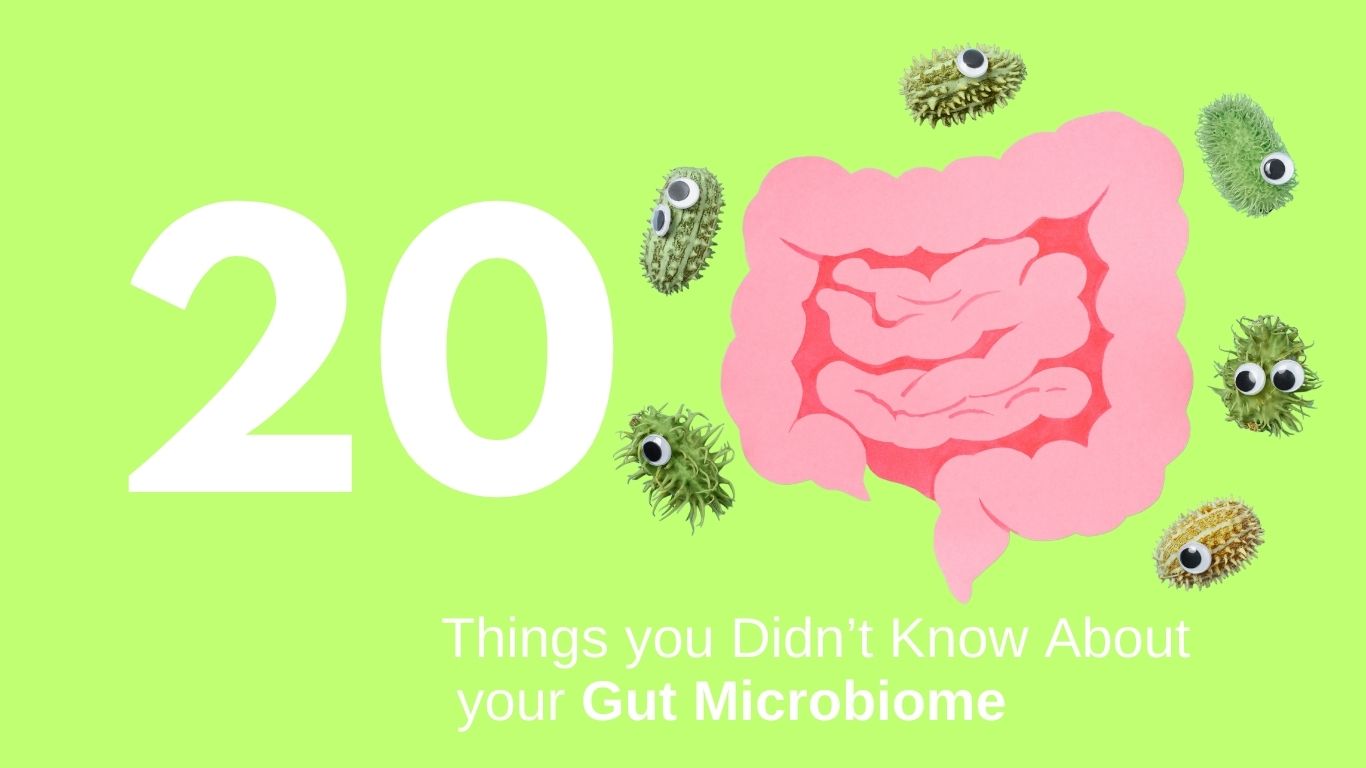Unless you have avoided all mass media recently, you are likely hearing about the “gut microbiome”, and how people are sampling their own feces for the purposes of science, taking probiotics, eating loads of yogurt, kombucha or kimchi – to try to foster the “good” bacteria.
The science is exploding and we are just in the early stages of making some sense of it all, so here are 20 things about the gut microbiome taken from an article published in J Cardiovasc Nurs. that you might find helpful to know.
1. The microbiome is defined as all the bacteria, viruses, fungi, archaea, and eukaryotes that inhabit the human body.
Collectively referred to as the “second human genome”1, the gut microbiome in particular is now being considered a separate “organ” with distinct metabolic and immune activity.
2. There are 10x the number of microbial cells in the human gut than in the whole human body, totalling roughly 100 trillion microbes representing as many as 5,000 different species and weighing approximately 2 kilograms.2
There are other human microbiome sites as well, including skin, oral, and vaginal, but the gut is the most popular and diverse neighbourhood!
3. Until the entry of next generation sequencing in 2005 and the birth of metagenomics, the ability to measure the vast community of microbiota in the GI tract was not possible since most of the bacteria which reside in the gut are anaerobic and unable to be grown via culture.
4. Our understanding of the “normal” microbiome patterns, including what constitutes a healthy versus diseased pattern is still in its infancy. Only a few associations have been established in human studies thus far.
5. The Human Microbiome Project, funded by the NIH from 2007-2015 and the American Gut Project are the two major studies in the US aiming to characterize the composition and diversity of the human microbiome and establish a dataset library of human microbial communities. For a fee of $99, anyone can participate in the American Gut Project to get their gut microbiome sequenced http://humanfoodproject.com/americangut/.
6. Though once thought that the fetal intrauterine environment and GI tract were sterile, the evidence of microbes in meconium suggests that the microbiome may develop sometime during fetal development.3
The neonatal microbiome is further influenced by delivery type (vaginal versus C-section) and feeding type (breast milk versus formula) and continues to develop until age 2-3 years when the gut micobiota stabilizes and resembles that of adults.
7. Antibiotic therapy alters the patterns of gut microbiota and when given early in life (infancy and childhood) may shift the bacterial profile towards one that promotes obesity, metabolic abnormalities and/or autoimmune diseases.
This relationship is seen in livestock animals given low-dose antibiotics to enhance growth and weight gain, so this relationship in humans is also being explored.
8. “Normal” gut microbiota in healthy persons include such pathogenic strains as E. coli and Enterococci – but as of yet, there is no clear distinction of which are the good versus the bad bacteria,4 or if some have both roles.
9. Gut bacteria are involved in harvesting energy from food, balancing the good versus bad bacterial composition, manufacturing neurotransmitters such as serotonin, enzymes and vitamins like vitamin K and are involved with immune and metabolic functions.
10. The gut microbiome of Americans and most other Westernized, industrialized populations is less diverse and dominated by different bacterial species than that of people from rural, less developed populations.
Diet plays a role, but a general shift away from natural environments with little exposure to soil, animals, and other environmental microbes seems to be impacting the gut microbiome in potentially detrimental ways.
11. Children raised in homes with pets have less risk of allergic diseases and new evidence is demonstrating a link with gut microbiome patterns.
Exposure to dogs seems to alter the gut microbiome to be protective against allergic airway issues and respiratory viruses.5 So, Lucy was wrong and a dog kiss a day may help keep bad things away!
12. Gut microbiota differ in obese individuals versus lean individuals, and those with atherosclerosis, diabetes, and metabolic syndrome but the significance of these differences is not yet understood.6
13. Fecal microbiota transplant, a treatment that dates back over 1000 years to Chinese practitioners and was first published as a modern therapeutic intervention in 1958,7 is the process by which a fecal sample from a “healthy” individual is transplanted into the gut via enema, nasogastric tube or colonoscopy of a diseased patient.
It has been the most successful treatment for patients with antibiotic resistant C. difficile thus far.8
A nonprofit organization called OpenBiome (http://www.openbiome.org/) collects and store fecal samples for fecal microbiota transplant for C. difficile patients. This is a new era of “organ” transplant!
14. Fecal microbiota transplant from lean healthy donors has also found to be successful in improving insulin sensitivity in men with metabolic syndrome.9
15. Diet seems to be the most powerful influence of the gut microbiome.
Processed foods containing emulsifiers and detergent-like compounds may damage the intestinal lining, potentially leading to “leaky gut” and systemic inflammation (contributing to inflammatory-based diseases such as diabetes and CVD).
16. Fibres – including food-based resistant starch, soluble fibre and insoluble fibre are some of the key nutrients for promoting fermentation and ensuring a diverse microbiome.
Such non-digestible dietary components are known as prebiotics, which stimulate the growth or activity of the gut microbiota.
17. A wide diversity of gut microbiota is currently thought to be the healthier composition than having only a select few bugs.
This diversity is affected by a varied diet rich in plants, vegetables and fruit, so those who have a limited diet also have a low diversity of microbiota.
18. Aging is associated with decreasing microbial diversity and the reduced diversity correlates with nutritional status, increased inflammation and frailty.11
19. In one study, individuals with type 2 diabetes (T2D) had a gut microbiome composition that was distinctive enough to be more predictive of the disease state than BMI compared to control subjects.12 The individuals with T2D had fewer bacteria with anti-inflammatory properties. The shift in gut microbiota following gastric bypass may be the reason why T2D is improved or resolved even before weight reduction begins.13
20. So, to conclude – what we don’t know about the gut microbiome and its contribution to health and disease is a lot more than what we do know. But one thing is for sure – this is a tremendous area of research with new discoveries and relevant cardiovascular implications, published even faster than we could outline this list.
There seems to be great potential for the role of this second human (or non-human, rather) genome and the role it may have in future therapeutic targets.
Who knew the power of feces or the smooch of a pup!

References
Published in final edited form as: J Cardiovasc Nurs. 2014 Nov-Dec; 29(6): 479–481. Author manuscript; available in PMC 2015 Nov 1. PMID: 25290618 NIHMSID: NIHMS589935 PMID: 25290618 doi: 10.1097/JCN.0000000000000166

